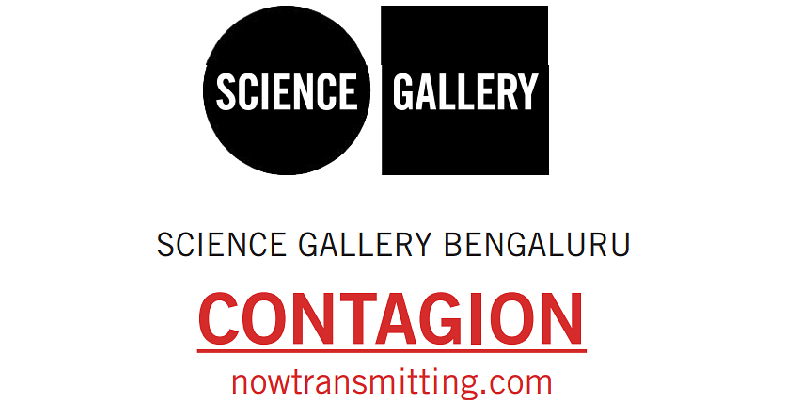Launched in 2014, PhotoSparks is a weekly feature from YourStory, with photographs that celebrate the spirit of creativity and innovation. In the earlier 535 posts, we featured an art festival, cartoon gallery. world music festival, telecom expo, millets fair, climate change expo, wildlife conference, startup festival, Diwali rangoli, and jazz festival.
Science Gallery Bengaluru’s 45-day exhibition, titled CONTAGION, is wrapping up the first phase of its online gallery and lecture/workshop series on June 13. But the virtual resources, most exhibits, and a fresh round of online events will be accessible till the end of the year.
The exhibition explores the spread of diseases, emotions, behaviours, and information in local and global contexts. A free Activity Handbook with exercises and resources has been provided as a downloadable PDF.
“CONTAGION has attracted visitors from across the country and the world. We have offered sessions and mediator-led interactions in English, Kannada, Hindi, Tamil, and Telugu,” explains Jahnavi Phalkey, Founding Director of Science Gallery Bengaluru, in a chat with YourStory.
“The mandate of the Science Gallery Network across the globe is to invite an engagement with science in such a manner that our visitors can link their experiences with scientific research,” she explains. The engagement is more exploratory than pedagogical or didactic.
Jahnavi Phalkey
Science Gallery Bengaluru
Science Gallery Bengaluru (SGB) is a not-for-profit public institution for research-based engagement. It has received founding support from the Government of Karnataka and three academic partners: Indian Institute of Science, National Centre for Biological Sciences, and Srishti Institute of Art, Design and Technology.
SGB is a member of the Global Science Gallery Network with sister galleries in Atlanta, Berlin, Detroit, Dublin, London, Melbourne, Rotterdam, and Venice. Science Gallery International was established in 2012, and builds on the success of Science Gallery Dublin at Trinity College Dublin.
SGB is positioned as a platform at the intersection of science, culture, and experimentation. Content is free to access, and is available in both English and Kannada. The online gallery is already live, with the physical centre is slated for launch next year. Earlier physical exhibitions have been held at Rangoli Metro Arts Centre and Bangalore International Centre.
The exhibitions were titled ELEMENTS (October 2019, to mark 150 years of Mendeleev’s periodic table), SUBMERGE (December 2020 – January 2021, to mark the Government of Karnataka’s Year of Water), and PHYTOPIA (August 2020, to mark the United Nations’ International Year of Plant Health).
Dr Jahnavi Phalkey, Founding Director of SCB, is a historian of contemporary and twentieth-century science and technology. She was earlier at the India Institute at King’s College London. She is the author of Atomic State: Big Science in Twentieth Century India and has co-edited Science of Giants: China and India in the Twentieth Century. Jahnavi is also the producer-director of the documentary film Cyclotron.
Exhibition team
The CONTAGION exhibition has been put together by the Robert Koch Institute, the Indian National, Science Academy, and DBT/Wellcome Trust India Alliance. Other partners are the Jenner Trust, US Consulate General Chennai, and the Chennai Photo Biennale Foundation. Content partners include John Innes Centre at Norwich, UK.
Curated by Danielle Olsen, International Cultural Producer at the Wellcome Trust, and Jahnavi Phalkey, CONTAGION features 16 interactive exhibits and more than 40 live programmes that connect art, technology, and science.
The exhibition is guided by a multidisciplinary panel of scholars consisting of a historian of medicine Sanjoy Bhattacharya, virologist Shahid Jameel, and physicist/biologist Mukund Thattai. More than 45 artists and scholars participated in the initiative, led by a team including Gayatri Manu, Komal Jain, Sankalp Singh, Shweta Jangir, Vasudha Malani, and Madhushree Kamak.
CONTAGION exhibits
CONTAGION exhibition
The exhibition features online galleries, film screenings, lectures, quizzes, masterclasses, and workshops. There are also curated reading and audio materials, an Activity Handbook, and even online games.
The exhibits are themed as Trigger, Transmission, Spillover, and Hindsight, and offer a multi-disciplinary perspective of pandemics through the ages (see videos here). The diverse exhibits invite multiple entry points for engineers, designers, mathematicians, computer scientists, doctors, epidemiologists, policymakers, artists, educators, students, and many more.
The exhibits include A Cluster of 17 Cases (SARS spread in Hong Kong’s Metropole hotel), Mapping Cholera (in New York City and Haiti), and Drawing the Bombay Plague and Fluid Dialogues (HIV stigmas).
Other exhibits address computer viruses and even the spread of fake news. The backstory of each exhibit and expert is also accessible online, in the form of interviews, interactions, storyboards, or sample code.
CONTAGION CO-VIDS
Sessions and workshop topics include Control, Consensus, Chaos: The Global Response to the Pandemic; Visualising and Interpreting Mutations; Modeling of Infectious Diseases; Plant Viruses; Dealing With the Infodemic; Public Education; Making Sense of 24X7 Online News; and How Ideas and Behaviours Spread Through a Crowd.
Other topics include Contagious Cartography; Humans Rights and Knowledge During Crises; Lessons from SARS, AIDS and Ebola Epidemics; Digital Epidemiology; Design as a Medium for Collective Critical Care; Emergence of Epidemic Photography; Vaccines and Storytelling; and The Art of Pandemics.
There were 16 exhibits and 15 films (‘Co-Vids’), with 54 scholars and artists participating in 22 lectures, 19 tutorials, 12 workshops, and six masterclasses. There were 193 mediator-led sessions and four film discussions as well.
Science Gallery Bengaluru mediator in conversation with visitors at SUBMERGE, 2019
Audience participation
Science Gallery Bengaluru and the Chennai Photo Biennale (CPB) Learning Lab invited young adults to participate in their Photography Prompts programme. Participants sent photographs, GIFs, or short videos on the themes Behind the Mask, Isolation, Home, Bubble, and Viral.
There was also a Writing Prompts programme, for submissions of prose or poetry. Some of the prompts were themed on human co-existence with nature, future vaccines, virality in marketing, computer viruses, alien visitors, and even a mass outbreak of laughter.
“We received close to a hundred submissions in response to our prompts. The responders ranged from documentary photographers, researchers, artists, to even psychologists and writers,” Jahnavai observes.
The submissions were most interesting because they spoke of personal experiences of living through difficult times, she adds.
Activity Handbook exercise
“We encourage our audience to ask questions and provide the opportunity to seek answers to them. More than a hundred questions were asked during Gagandeep Kang’s talk, for example,” she adds. There were also smaller closed-door tutorial sessions where younger audiences could raise questions without inhibition.
Each artist and scholar exhibiting at CONTAGION interacted closely with 37 mediators over several sessions in the months leading up to the exhibition. The mediators and audiences are mostly in the 18-28 age group.
Each speaker in the public lecture series gives an open-to-all talk, with a question and answer session. This is followed by a tutorial session for up to 30 young adults where the discussion is based on a pre-circulated set of readings, Jahnavi adds.
COVID art
Insights and impact
“Living with COVID-19 has highlighted our connectedness and the importance of nurturing international collaboration,” according to Danielle Olsen, International Cultural Producer, Wellcome Trust, pointing to the importance of sensemaking in uncertain times.
“Knowledge about the unfolding situation is being revised rapidly for more than twelve months,” adds Jahnavi Phalkey. The swift changes in understanding the virus and preventive practices call for creative responses in formulating questions and devising answers.
She also shared some audience feedback and comments. “CONTAGION has such a variety of talks available expanding into the fields of both arts and science, which is very rare for me,” according to Kandhway Ilvika, Navi Mumbai (age group: 15-21 years).
Still from The Chameleon Project by Tina Gonsalves (2008-2010) – Image courtesy of the artist and Phillip Carr
“It also helps create an awareness that society has to start dealing with these issues through science and engaged culture,” writes Rajesh Gopakumar, physicist, International Centre for Theoretical Sciences.
“It is also important for people to be able to use technological means to stay connected, and exhibitions like CONTAGION help us reflect and share information as public intellectuals,” according to Ananya Kabir, cultural and literary historian, King’s College London.
“It also provides us with an in-depth understanding of the pandemic as a biological process, a social process, and their own experiences,” adds Christos Lynteris, Medical Anthropologist, University of St Andrews.
Jahnavi Phalkey
The road ahead
“We are grateful to the artists and scholars, most of whom have agreed to keep their work accessible for longer in the exhibition without additional fees. Thanks to them, we are now able to keep the exhibition running with fresh monthly programming until December 31, 2021,” Jahnavi proudly says.
All resources, other than some live exhibits that belong to the artists/scholars, are archived online and accessible for free. “The public lecture series and events are also recorded and uploaded to our YouTube channel,” she adds. These can be used to spur further discussions and activities.
“We would like to invite more audiences to visit the online exhibition. We invite them to participate in the programmes and explore the close to 500 resources available to read, watch and play across the website,” Jahnavi says.
“The online resources from the some of the world’s best minds speak to the idea of transmission – not only of disease but also that of ideas, behaviours and emotions,” Jahnavi signs off.
Now, what have you done today to pause in your busy schedule and find new avenues to harness your exploratory and creative core?
Illustration by David S. Goodsell – Image available under Creative Commons License
Still from Mapping Cholera – A Tale of Two Cities (2014); by Sonia Shah and Dan McCarey; Image courtesy of the artists
Still from Mapping Cholera – A Tale of Two Cities (2014) – by Sonia Shah and Dan McCarey
A Cluster of 17 Cases by Blast Theory (2018); Image courtesy of the artist
A still from A Cluster of 17 Cases (2021) by Blast Theory, image courtesy of the artist -3
Ant carrying leaf fragments – from the exhibit ‘Putting the Ant into Antibiotics’ – Image Courtesy of John Innes Centre
Barber at work in one of the camps, 1897, Karachi Plague Committee Album, Photograph probably by R. Jalbhoy, Wellcome Collection; From the exhibit Controlling the Plague in British India by Christos Lynteris
An electron micrograph of Tobacco Mosaic Virus; Wikimedia Commons, Public Domain
Left – Wall chart “How tuberculosis is transmitted”, 1920s Deutsches Hygiene-Museum / Production of teaching materials. Photo: Volker Kreidler. Image courtesy of Museum at Robert Koch Institute
Right – Self isolate if you feel unwell – Courtesy of Rusell Tate & the United Nations – Image source Unsplash
Still from Mapping Cholera A Tale of Two Cities (2014); by Sonia Shah and Dan McCarey
Still from Dis-Ease (2018) Image courtesy of filmmaker Mariam Ghani
Still from When the World was a Laugh (2021) by Anais Tondeur – image courtesy of the artist
Text cells from Vision 2020 by Robert Good; Image courtesy of the artist
Still from Vision 2020 (2020) by Robert Good; image courtesy of the artist
Still from Where Birds Dance Their Last (2013). Image courtesy of filmmaker Lena Bui
Activity Handbook illustrations
See also the YourStory pocketbook ‘Proverbs and Quotes for Entrepreneurs: A World of Inspiration for Startups,’ accessible as apps for Apple and Android devices.
(Images sourced from Science Gallery Bengaluru and exhibition publications)










![Read more about the article [The Turning Point] How Sridhar Vembu-led Zoho came back stronger after dotcom burst](https://blog.digitalsevaa.com/wp-content/uploads/2022/05/MalvikaCopyofImageTagging88-1653727945479-300x150.png)